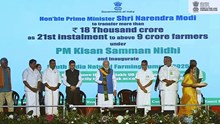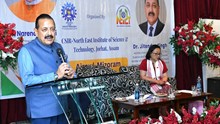
Prime Minister Narendra Modi, on January 18, 2025, distributed over 65 lakh property cards under SVAMITVA scheme to property owners in more than 50,000 villages across 230 districts in 10 states and 2 Union Territories. Speaking at the event held via video conferencing, Prime Minister described the occasion as transformative for rural India, extending his heartfelt congratulations to the beneficiaries.
Reflecting on the journey of SVAMITVA scheme, launched five years ago, PM Modi highlighted its aim to grant legal property rights to rural residents. Over 1.5 crore property cards have been issued since its inception, with today's distribution marking a significant step forward. “Under the Swamitva Yojana, around 2.25 crore people in villages now have legal documents for their homes,” remarked Modi, emphasizing the profound economic and social impact of these initiatives.
Acknowledging global challenges, Modi cited a United Nations study highlighting the lack of legal property documents as a barrier to poverty alleviation. Drawing on insights from renowned economists, he pointed out that the absence of property rights often leaves rural assets as "dead capital," hindering economic growth. He noted that India, too, faced this challenge, with villagers struggling due to disputes, illegal occupations, and limited access to financial institutions.
Through the innovative use of drone technology, Swamitva Yojana has digitized property records, enabling villagers to access loans and start small businesses. Modi shared the transformative stories of beneficiaries, many of whom belong to Dalit, backward, and tribal communities. “Once property cards are issued in all villages, it will unlock economic activities worth over 100 lakh crore rupees,” he stated.
The scheme’s impact extends beyond economic empowerment. It has streamlined village development planning, reduced disputes, and strengthened disaster management. Digitizing land records through Bhu-Aadhaar has further revolutionized rural governance, with over 23 crore land parcels now uniquely identified. Modi highlighted that 98% of land records have been digitized, a significant achievement in modernizing rural infrastructure.
Reiterating his commitment to Mahatma Gandhi’s vision of Gram Swaraj, Prime Minister highlighted the steps made in rural development over the past decade. He cited the electrification of over 2.5 crore families, construction of 10 crore toilets, provision of 12 crore tap water connections, and establishment of Ayushman Bharat health centers. Additionally, over 8.25 lakh kilometers of rural roads have been constructed under Pradhan Mantri Gram Sadak Yojana, with nearly half completed in the last decade.
Highlighting women’s empowerment, Modi noted that schemes like PM Awas Yojana have prioritized registering houses in women’s names, while initiatives like Lakhpati Didi Yojana have created economic opportunities. “Under the Swamitva Yojana, many property cards now include wives' names, strengthening their rights,” he remarked, adding that women were also being trained as drone pilots through Namo Drone Didi Yojana, enhancing their income.
Concluding his address, Modi expressed confidence in the transformative power of the Swamitva Yojana, asserting that strong, self-reliant villages will pave the way for a developed India. The event saw participation from Governors, Chief Ministers, and other dignitaries.
















